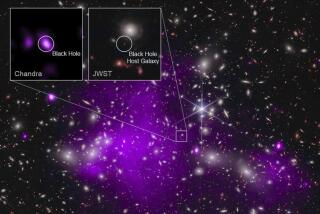Stephen Hawking talks about unified theory and his biggest ‘blunder’
Humans are on the cusp of discovering how the universe works on its biggest and smallest scales, Stephen Hawking said during a lecture Tuesday in Los Angeles.
The renowned theoretical physicist made his name studying black holes, massive structures that anchor galaxies and whose gravity is so strong that not even light can escape.
But on Tuesday, he delved into the world of microscopic cell biology to see first-hand how researchers at the Cedars-Sinai Regenerative Medicine Institute are using stem cells to develop treatments for amyotrophic lateral sclerosis, or ALS, the disease Hawking was diagnosed with in 1963.
[For the Record, 9:03 a.m. PDT April 12: An earlier version of this post stated that ALS had kept Stephen Hawking in a wheelchair since 1963. He was diagnosed with the disease in that year.]
In an hourlong talk at Cedars-Sinai for hospital employees, ALS patients and their families, Hawking discussed his childhood, cosmology and what he sees in the universe’s future.
Just minutes after taking a tour of the medical center’s stem cell labs directed toward studying ALS treatments, Hawking drew parallels between the center’s work in discovering the mechanisms of disease and his quest to understand the fundamental rules of the universe.
“If you understand how the universe operates, you control it in a way,” said the author of “A Brief History of Time,” which has sold millions of copies.
The British scholar said his mind’s hunger for answers was never satisfied with what was known growing up. He said he had questions -- most of them theoretical -- that demanded answers. He found his calling at the University of Cambridge’s cosmology department and held the Lucasian Chair in Mathematics at the university for 30 years. Isaac Newton once held the same chair.
At Cambridge, Hawking pioneered groundbreaking research into how particles behaved around black holes, and deduced that the black holes spit out radiation as they swallow up matter. Hawking said his previous, long-held belief that everything swallowed by a black hole was lost forever was the “biggest blunder” of his scientific career.
For him, the answers to the largest and tiniest questions lie in M-theory.
“To understand the universe at the deepest level, we have to understand why is there something rather than nothing,” Hawking said, speaking through a computer program that converts his eye and cheek movements into spoken speech. “Why do we exist? Why this particular set of laws, and not some other? I believe the answers to all of these things is M-theory.”
The theory, he said, combines multiple ideas about math and physics. It suggests that there are multiple dimensions or universes, and offers solutions for the behavior of super-massive black holes and the properties of the fabric of space-time. M-theory is a work in progress, but Hawking said he believes that it’s the most promising lead to a unified theory.
The payoff to solving M-theory, Hawking said, is understanding where we fit in -- and, perhaps, how we can thrive.
“We must continue to go into space for humanity,” Hawking said. “We won’t survive another 1,000 years without escaping our fragile planet.”
Kenneth Leeds, associate director of the ethics center at Cedars-Sinai and one of the hospital employees who attended the speech, said he admired the physicist’s accomplishments given his challenges of dealing with ALS.
Leeds has worked with people suffering any number of conditions, so he had a special appreciation of Hawking’s admission that he was afraid to ask his doctor about his diagnosis before he was told he had ALS.
“Here’s a man who’s M.O. is to ask questions, and he didn’t want to ask,” Leeds said. “This is a very human thing.”
Hawking concluded his speech by urging the audience to keep asking questions.
“Your universe is a great triumph,” he said. “I want to share my enthusiasm and excitement about this great quest. So remember to look up at the stars and not at your feet. ... Be curious. And however difficult life may seem, there is always something you can do and succeed at.”
Return to the Science Now blog.







